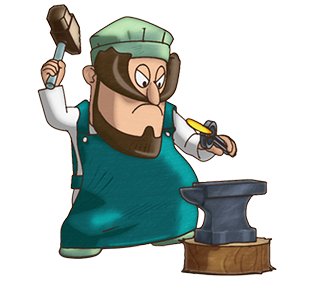


There was a variety of Medieval Blacksmith tools and equipment.
#LIFE IS FEUDAL WIKI BLACKSMITH HAMMER PORTABLE#
A Portable forge was a light and compact blacksmith's forge, with bellows, etc., that may be moved from place to place. A Forge wagon was a wagon fitted up for transporting a blackmith's forge and tools. Steel is therefore a variety of iron containing more carbon than wrought iron and an excellent metal for making the weapons so sought after during Medieval times.Ī Blacksmith forge is a workplace where metal is worked by a blacksmith by heating and hammering via a furnace consisting of a special hearth where metal is heated before shaping The name of a forge was also referred to as a a smithy. As cast iron, it is easily fusible as steel, is very tough, and (when tempered) very hard and elastic. Thus, when heated iron is malleable and ductile, and can be easily welded and forged at a high temperature. The value of iron is largely due to the facility with which it can be worked by a blacksmith. Repeatedly heating the iron in a forge and hammering it was the method the Blacksmith used for carburizing.

Carburizing, that is the addition of a small amount of carbon (between ½% - 2%) and quenching turned the iron into steel suitable for making weapons and tool manufacture. The iron used by the blacksmith required shatterproof hammers with handles and iron tongs to hold the work piece in place. Iron worked by the Medieval Blacksmith - Turning iron into steel While 'Smith' may have first appeared in its current form in Middle English, it is really a much older word, probably based on a prehistoric German word meaning "worker" or "craftsman."ĭescription of a Blacksmith: A smith who works in iron metal, especially by hammering it when it is hot and malleable, working with a forge making iron utensils, horseshoes, weapons and repairing armor. A blacksmith was named because he was a 'smith' who worked in the "black" metal namely iron as opposed to the "white" metals such as tin, silver or gold. A 'Smith' was described according to the metals that he worked such as a goldsmith, silversmith or a blacksmith. A 'Smith' is someone who works with metal (especially by hammering it when it is hot and malleable). Facts and interesting information about Medieval Life,ĭefinition and origin of the term Blacksmith: A Blacksmith is a combination of the two words 'black' and 'smith'.


 0 kommentar(er)
0 kommentar(er)
